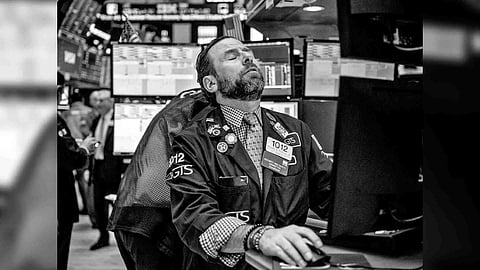

MARIE SOLIS
Almost everyone knows someone who seems to take a perverse pleasure in imagining worst-case scenarios. In life, this is usually a coping mechanism devised to cushion the blows of disappointment. In markets, it is a way to make billions of dollars.
But converting market anxiety into eye-popping personal gain — by shorting stocks in the off-chance the economy tanks — can be an unsavoury strategy, and not just because it can mean profiting off disasters like Sept. 11 and Covid. In the school of Nassim Taleb, the former derivatives trader and “Black Swan” theorist, betting on catastrophe requires acknowledging that we can never know when it will strike. And while that may sound like a bland truism, it goes against much of the conventional wisdom on Wall Street, which says that with the right statistical models, nearly every outcome is quantifiable. The frightening alternative would be to admit that chaos reigns. Of course, it’s chaos that Taleb thrives on. He is the unwitting protagonist of The Wall Street Journal reporter Scott Patterson’s “Chaos Kings,” a closely observed chronicle of the storm-chasing edgelords of finance and the critics with whom they clash.
This drama unfolds in lecture halls, in conference rooms and on trading floors, which lend themselves naturally to drama. In an early scene, a young Taleb finds the “meaty fists” of a hotheaded pit trader wrapped around his neck. The men who make up the cast are daredevilish and eccentric. They ride motorcycles at “suicidal speeds,” and hire kung fu masters to learn qinna, an intricate martial art technique of physically incapacitating an opponent. And they learn to love losing money day to day, so that they can win big down the line.
Even those unfamiliar with, or uninterested in, the oscillations of the stock market may find themselves gripped by Patterson’s account, which returns to pivot points like the 1987 Black Monday, the 2008 financial crisis and the 2010 flash crash, and ambitiously, though not always as successfully, tries to connect these events in a single thread to the present day.
The world Patterson portrays is largely divided among two camps: investors who subscribe to Taleb’s “Black Swan” philosophy of financial markets as vulnerable to unforeseeable shocks and those more convinced by the French researcher Didier Sornette’s “Dragon Kings,” anomalous but somewhat foreseeable events. Sornette, who steadfastly believes in “pockets of predictability,” finds Taleb and his partner Mark Spitznagel’s credo a touch too woo-woo. “Quants,” the financial engineers who trust complex formulas to tell them what the future holds — and who are the focus of another book by Patterson — are the extreme foil to both groups.
“The Black Swan concept is dangerous,” Sornette tells Patterson. “It puts us back at the time of pre-science where the wrath of nature, the lightning, the storms were the expression of the anger of the gods.” Patterson doesn’t come out and say what we should think of these camps: He is primarily showing us how their machinations work. But rarely does the reader see his chaos kings err, and as the author threads in more contemporary issues like the climate crisis, cryptocurrency and the war in Ukraine, we see their ideas becoming only more ascendant.